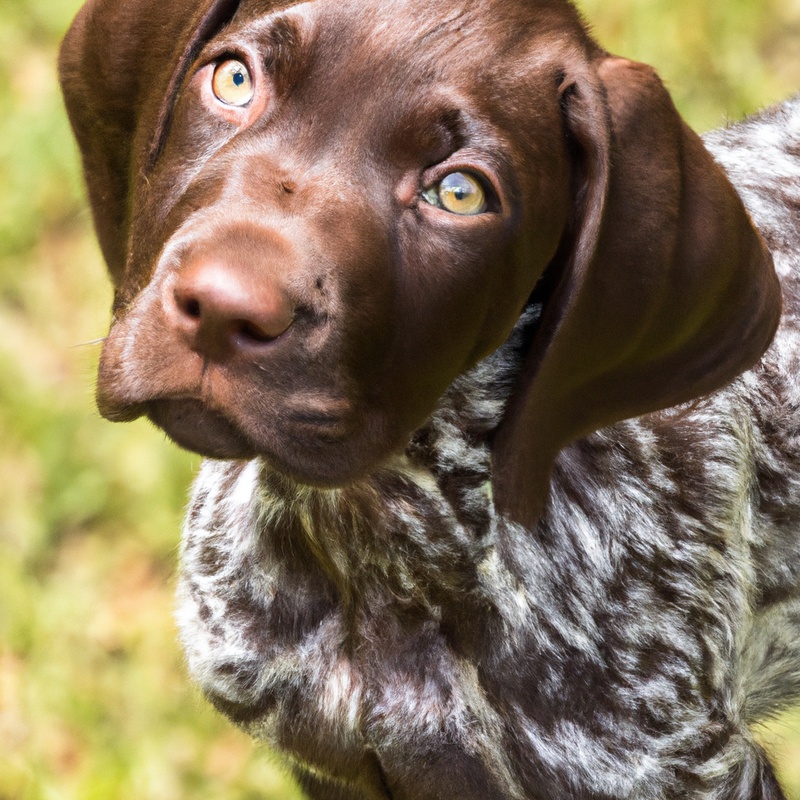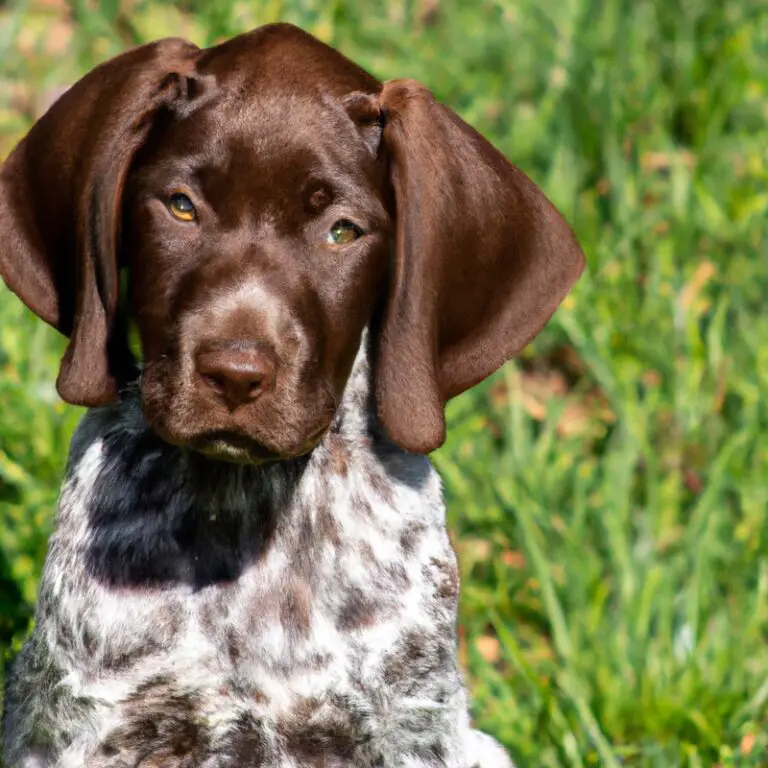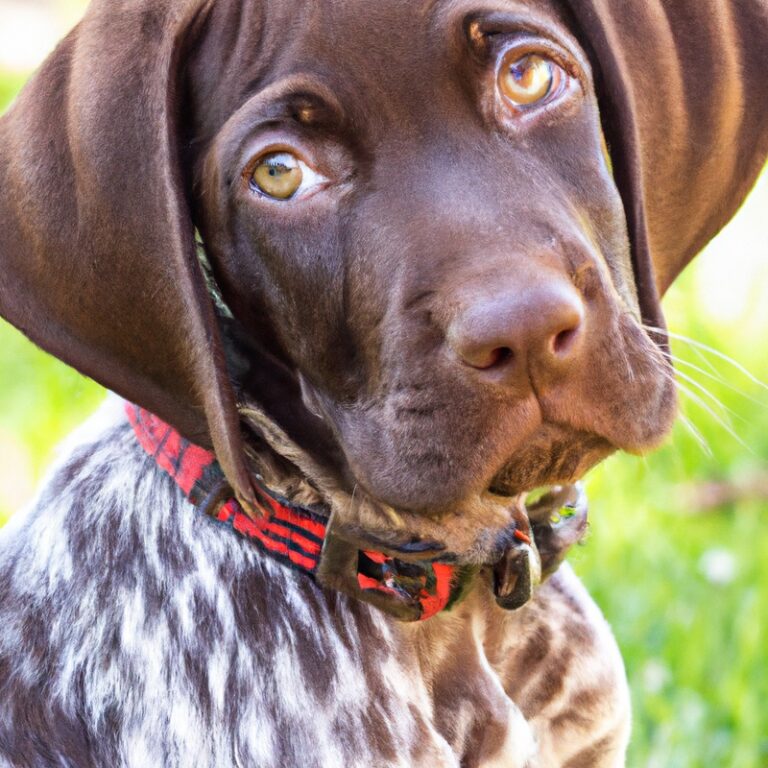How Do I Prevent My German Shorthaired Pointer From Counter Surfing When I’m Not Home?
Key Takeaways:
- Use consistent training and reinforcement to establish clear boundaries and teach the “leave it” command.
- Remove temptations from countertops and secure trash cans to minimize access to food.
- Provide mental and physical stimulation through regular exercise and interactive toys to reduce the dog’s desire to counter surf.
- Consider crate training or using baby gates to restrict access to areas with countertops when you’re not around.
Have you ever walked into your kitchen only to find your German Shorthaired Pointer perched on the counter, happily munching on a forbidden treat? If so, you’re not alone.
Counter surfing, or the act of dogs helping themselves to food and other items off counters and tables, is a common challenge faced by many dog owners.
But fear not! In this article, I’ll share some effective strategies to prevent your German Shorthaired Pointer from counter surfing, even when you’re not at home. From understanding their natural instincts to creating a safe environment, we’ll explore practical techniques to keep those counters dog-free.
So, let’s dive in and reclaim our kitchen surfaces!
| Prevention Methods | Effectiveness | Difficulty Level |
|---|---|---|
| 1. Establish clear boundaries | High | Medium |
| 2. Use baby gates or barriers | High | Low |
| 3. Keep counters clear and clean | Medium | Low |
| 4. Use remote training techniques | Medium | High |
| 5. Provide mental and physical stimulation | Medium | Medium |
Understanding the Behavior of German Shorthaired Pointers
The Natural Instincts of German Shorthaired Pointers
German Shorthaired Pointers have strong natural instincts that influence their behavior. They were originally bred as hunting dogs, so they have a strong prey drive and a keen sense of smell.
They are also intelligent and highly energetic.
These natural instincts can manifest in various ways, such as their tendency to explore, chase small animals, and jump on furniture. It’s important to understand and respect these instincts when training and managing your German Shorthaired Pointer.

Factors That Contribute to Counter Surfing Behavior
Counter surfing behavior in German Shorthaired Pointers can be influenced by several factors. First and foremost, their strong sense of smell plays a significant role.
These dogs have an excellent sense of smell and are naturally curious, making them more likely to investigate enticing scents coming from the countertops.
Another factor is their high energy levels. German Shorthaired Pointers are energetic and agile dogs.
If they are not given enough mental and physical stimulation, they may resort to counter surfing as a form of entertainment or to alleviate boredom.
Similarly, lack of proper training and reinforcement can contribute to this behavior. If a dog learns that they can access food or other rewards from the countertops without any consequence, they are more likely to continue the behavior.
Consistent training and positive reinforcement are essential in curbing this behavior.
Furthermore, inconsistency in household rules can confuse the dog. If sometimes they are allowed to scavenge for food on the countertops and other times they are reprimanded for it, it creates mixed signals.
This can lead to counter surfing becoming a learned behavior.
Lastly, the accessibility of the countertops themselves is a contributing factor. If the countertops are easily accessible or there are no preventative measures in place, such as baby gates or training the dog to stay out of the kitchen, it becomes easier for the dog to engage in counter surfing behavior.

Identifying Counter Surfing Triggers
Common Triggers for Counter Surfing
Common Triggers for Counter Surfing One common trigger for counter surfing is the smell of food left out in the open. Your German Shorthaired Pointer has a powerful sense of smell and will be tempted to explore any delicious scents.
Another trigger is boredom or frustration.
If your GSP is not adequately stimulated, they may seek out the excitement and potential rewards of counter surfing. Additionally, a lack of training or boundaries can make counter surfing more appealing to your dog.
Inconsistency in enforcing rules can confuse them and lead to unwanted behavior.
Recognizing Signs of Counter Surfing
Recognizing Signs of Counter Surfing is key to addressing the issue effectively. First and foremost, keep an eye out for any food-related items that mysteriously disappear or are found in odd places.
This could indicate that your German Shorthaired Pointer has been up to some counter surfing mischief.
Look for crumbs or food residue on your dog’s face or paws as well. Additionally, watch for behavior such as sniffing, staring, or hovering around the kitchen countertops.
These signs may indicate a potential interest in exploring the forbidden treasures on the counter.
Strategies to Prevent Counter Surfing
Creating a Safe and Secure Environment
Creating a safe and secure environment for your German Shorthaired Pointer is essential to prevent counter surfing when you’re not home. Here are some key steps you can take:
- Store food securely: Keep food items locked in cabinets or stored away in sealed containers to discourage your dog from accessing them.
- Clear the counters: Remove any tempting items from the counters, such as food, dishes, and other objects that might catch your dog’s attention.
- Use baby gates: Block access to areas where counters are located using baby gates or barriers to limit your dog’s movement.
- Utilize crate training: Consider crate training your dog to create a safe space for them when you’re not home and to prevent them from accessing the kitchen or other areas.
- Provide mental stimulation: Engage your dog in activities, such as puzzle toys and interactive games, to keep their mind occupied and reduce their interest in counter surfing.
By creating a safe and secure environment, you can significantly reduce the risk of counter surfing and ensure your dog’s well-being.

Using Positive Reinforcement Training Techniques
Using positive reinforcement training techniques is a great way to prevent counter surfing in your German Shorthaired Pointer. Here are some tips to help you out:
- Reward good behavior: When your dog is not counter surfing, praise and reward them with treats or verbal affirmations. This reinforces the behavior you want to see more of.
- Use commands: Teach your dog commands like “leave it” or “off” and reward them when they follow these commands. This helps them understand what you expect them to do when they approach the counters.
- Set clear boundaries: Make sure your dog knows that the counters are off-limits. You can use barriers, like baby gates or closed doors, to physically limit their access to the kitchen or dining area.
- Remove temptations: Keep counters clear of food or other items that might tempt your dog. This reduces the likelihood of them being enticed to jump up and surf for goodies.
- Provide alternative outlets: Make sure your dog has plenty of toys, chews, and activities to keep them mentally and physically stimulated. Boredom can often lead to unwanted behaviors like counter surfing.
Utilizing Interactive Toys and Puzzles
Utilizing interactive toys and puzzles can be a great strategy to prevent counter surfing in your German Shorthaired Pointer. These toys and puzzles keep your dog mentally stimulated and occupied, diverting their attention away from the countertops.
One option is to use treat-dispensing toys.
These toys require your dog to work for their treats by solving a puzzle or manipulating the toy. This not only keeps them engaged but also satisfies their natural instinct to forage and search for food.
Another idea is to provide your dog with interactive puzzle games.
These games require your dog to solve problems or complete tasks to access their rewards. They can be a fun and challenging way to keep your dog busy and mentally stimulated, reducing the likelihood of them seeking out food on the countertops.
Implementing Management Techniques
Implementing management techniques is key to preventing counter surfing when you’re not at home. Here are a few effective strategies you can try:
- Clear the counters: Remove any temptations such as food, dirty dishes, or enticing smells from the counters. This reduces the likelihood of your German Shorthaired Pointer being interested in counter surfing.
- Use barriers: Set up physical barriers like baby gates or crates to restrict access to the kitchen or any other rooms with counters. This prevents your dog from reaching the counters and getting into trouble.
- Use deterrents: Place harmless items near the edge of the counter that are designed to startle your dog, such as cans filled with pennies or motion-activated devices that emit a loud noise. This teaches your dog to associate counter surfing with unpleasant experiences.
- Provide alternatives: Make sure your dog has plenty of appropriate toys and activities to keep them occupied. This can include puzzle toys, chew toys, or interactive games. Redirecting their attention to these options can prevent them from seeking entertainment on the counters.
Consistency and Persistence
The Importance of Consistency in Training
Consistency in training is super important. When you’re trying to teach your German Shorthaired Pointer (GSP) anything, whether it’s obedience commands or not counter surfing, you need to be consistent.
Consistency means that you’re using the same cues, gestures, and reinforcements each time.
It helps your GSP understand what you want from them and what behavior is acceptable. If you’re inconsistent, your GSP will get confused and won’t know what to do.
So, be consistent with your training sessions.
Set aside regular times each day to work on specific skills or behaviors. Use the same commands and rewards consistently.
And most importantly, be patient and persistent.
Rome wasn’t built in a day, and your GSP won’t learn everything in one session.
The Role of Persistence in Changing Behavior
Persistence plays a crucial role in changing behavior. When it comes to modifying an unwanted behavior, it’s important to stick with it consistently and not give up too soon.
By being persistent, you show your German Shorthaired Pointer that the behavior is not acceptable and needs to change.
It may take time, but with persistence, your dog will eventually learn and adapt to the new desired behavior.
Seeking Professional Help
Consulting with a Dog Trainer or Behaviorist
If you’re struggling to prevent your German Shorthaired Pointer from counter surfing while you’re not home, consulting with a dog trainer or behaviorist can be a great solution. These professionals have the expertise and experience to address specific behavioral issues in dogs.
By seeking their guidance, you can benefit from their knowledge of canine behavior and training techniques.
They can help you understand the underlying reasons behind your dog’s counter surfing behavior and provide you with effective strategies to prevent it. A dog trainer or behaviorist will work with you and your dog to develop a customized training plan that suits your specific needs and goals.
They will teach you how to communicate effectively with your dog, set boundaries, and reinforce positive behavior.
Considering the Use of Anti-Counter Surfing Devices
Considering the Use of Anti-Counter Surfing Devices If you’re struggling to keep your German Shorthaired Pointer from counter surfing while you’re away, using anti-counter surfing devices may be worth considering. These devices are specifically designed to deter dogs from jumping up on countertops and stealing food.
Here are a few options to consider:
- Pet barriers or gates: These can be placed in doorways or entrances to keep your dog out of the kitchen or other areas where the counters are easily accessible.
- Remote deterrents: These devices use motion sensors and emit a high-pitched sound or a spray of harmless but unpleasant citronella when your dog gets too close to the counter.
- Counter mats or mats with sticky surfaces: These mats are placed on the counter and have a textured or sticky surface that makes it uncomfortable for your dog to step on.
- Puzzle feeders or interactive toys: By providing your dog with puzzle feeders or interactive toys filled with treats or food, you can redirect their attention and mental energy away from the counters.
Ensuring Physical and Mental Stimulation
Providing Sufficient Exercise
Providing sufficient exercise for your German Shorthaired Pointer is essential for their physical and mental well-being. They are an active and energetic breed that requires daily exercise to stay happy and healthy.
First and foremost, make sure to set aside dedicated time each day for exercise.
This can include activities such as brisk walks, runs, playtime at the park, or engaging in canine sports like agility or dock diving. It’s important to tailor the exercise routine to your dog’s age, health, and fitness level.
Engaging in Mental Stimulation Activities
Engaging in mental stimulation activities is essential for keeping your German Shorthaired Pointer happy and well-behaved. Here are a few ideas to help keep their minds busy while you’re not home:
- Puzzle toys: Invest in puzzle toys that require your dog to figure out how to get treats or toys out of them. This will keep their brain active and entertained.
- Interactive toys: Consider interactive toys that provide mental challenges. These toys may have compartments to hide treats or require your dog to solve puzzles to get rewarded.
- Treat-dispensing toys: Fill treat-dispensing toys with your dog’s favorite snacks before leaving the house. This will keep them occupied as they work to get the treats out.
- Hide and seek: Before leaving, hide treats or toys around your home and let your dog sniff them out. This game combines mental stimulation with physical activity.
- Training sessions: Use their alone time to reinforce their training by leaving them with specific tasks. Practice basic commands or teach them new tricks through positive reinforcement.
Managing Separation Anxiety
Identifying Separation Anxiety in German Shorthaired Pointers
Identifying Separation Anxiety in German Shorthaired Pointers can be important for their overall well-being. One key sign is excessive distress when left alone.
Your dog may display behaviors like whining, barking, pacing, or destructive chewing.
They may also try to escape or show signs of depression. Pay attention to any changes in behavior when you’re away.
If you suspect separation anxiety, consult with a veterinarian or a professional dog trainer who can guide you in developing a plan to help your furry friend.
Steps to Manage Separation Anxiety
Managing separation anxiety in dogs can be a challenging task, but with the right steps, it can be effectively managed. Here are some steps you can take to help your furry friend cope with separation anxiety:
- Gradual desensitization: Start by leaving your dog alone for short periods of time and gradually increase the duration. This helps them get used to being alone without becoming anxious.
- Establish a routine: Dogs thrive on routine, so establish a consistent schedule for feeding, exercise, and alone time. This can provide a sense of security and predictability for your dog.
- Create a safe space: Set up a designated area where your dog can feel calm and secure when you’re not home. This could be a crate, a specific room, or a comfortable bed with their favorite toys.
- Provide mental and physical stimulation: Engage your dog in stimulating activities before you leave, such as puzzle toys, interactive games, or a long walk. This helps tire them out and redirects their energy.
- Use positive reinforcement: Reward your dog for calm and relaxed behavior. This can include verbal praise, treats, or special toys. Positive reinforcement helps reshape their association with being alone.
Final Verdict
Understanding the behavior of German Shorthaired Pointers and recognizing the factors that contribute to counter surfing is crucial in preventing this unwanted behavior. By identifying triggers and signs of counter surfing, we can take proactive steps to create a safe and secure environment for our dogs.
Consistency, persistence, and positive reinforcement training techniques are key in changing behavior.
Seeking professional help and ensuring physical and mental stimulation further enhance our efforts. Together, these strategies will help us prevent counter surfing and foster a harmonious relationship with our furry companions.
Trust in the reliability of this information and take action to create a counter surfing-free home for your German Shorthaired Pointer.








